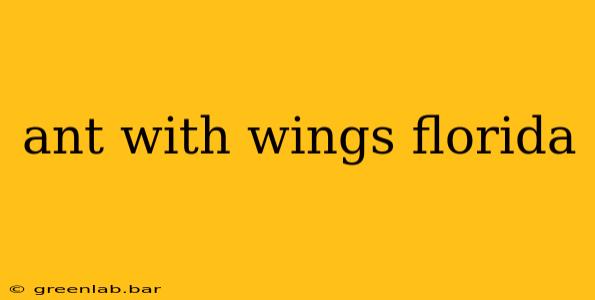Florida's warm, humid climate provides a perfect breeding ground for a variety of insects, including many species of ants. While most ants are wingless workers, the appearance of winged ants often causes alarm. This guide will help you identify flying ants in Florida and understand their behavior.
Types of Winged Ants in Florida
Several ant species in Florida develop winged reproductives (alates) – males and females with wings – during specific times of the year, usually after a rain. Identifying the exact species can be tricky, but here are some common culprits:
1. Carpenter Ants ( Camponotus species)
- Appearance: Large (1/4 to 1/2 inch long), black or reddish-black. They have a single node (a segmented bump) between their thorax and abdomen. Wings are relatively long and slender.
- Behavior: Carpenter ants don't eat wood like termites; they nest in wood, creating galleries. They prefer damp, decaying wood, but can infest structurally sound wood as well. Swarms typically occur in spring or fall.
- Damage: Structural damage to wood is their main concern.
2. Sugar Ants ( Monomorium pharaonis and others)
- Appearance: Small (1/16 to 1/8 inch long), light brown to yellow. They have a single node between their thorax and abdomen. Wings are proportionally shorter than carpenter ants.
- Behavior: These ants are attracted to sweet substances and often invade homes in search of food. Swarms can occur throughout the year, but are more common in warmer months.
- Damage: While they don't cause structural damage, their presence can be a nuisance and indicate a potential sanitation issue.
3. Odorous House Ants ( Tapinoma sessile)
- Appearance: Small (1/8 inch long), dark brown to black. They have a single node between their thorax and abdomen. They emit a characteristic rotten coconut smell when crushed.
- Behavior: They prefer sweet foods and are commonly found indoors. Swarms can happen at various times throughout the year.
- Damage: Similar to sugar ants, they are mainly a nuisance pest.
4. Fire Ants ( Solenopsis invicta and Solenopsis saevissima)
- Appearance: Relatively small (1/8 to 1/4 inch long), reddish-brown. They have two nodes between their thorax and abdomen.
- Behavior: Fire ants are aggressive and their stings are painful. Swarms are often a sign of colony reproduction.
- Damage: Fire ants can cause painful stings and damage to lawns and gardens.
Differentiating Flying Ants from Termites
A critical distinction needs to be made between flying ants and termites. Both have wings, but key differences exist:
| Feature | Flying Ants | Termites |
|---|---|---|
| Waist | Narrow waist between thorax and abdomen | Broad waist, almost no constriction |
| Antennae | Bent or elbowed antennae | Straight antennae |
| Wings | Front wings significantly larger than hind wings | Front and hind wings are similar in size |
| Body Color | Often darker (black, brown, reddish-brown) | Typically lighter (light brown, tan, creamy) |
What to Do If You See Flying Ants
If you're seeing a swarm of winged ants, don't panic. Identify the type of ant if possible, as this will guide your course of action. For larger infestations, or if you suspect termites, it's best to contact a professional pest control service in Florida. They can identify the species and recommend the appropriate treatment.
Remember to focus on preventative measures: seal cracks and crevices in your home, properly store food, and keep your home clean and dry to reduce the attraction of ants. Early detection and swift action are crucial in managing ant infestations.

